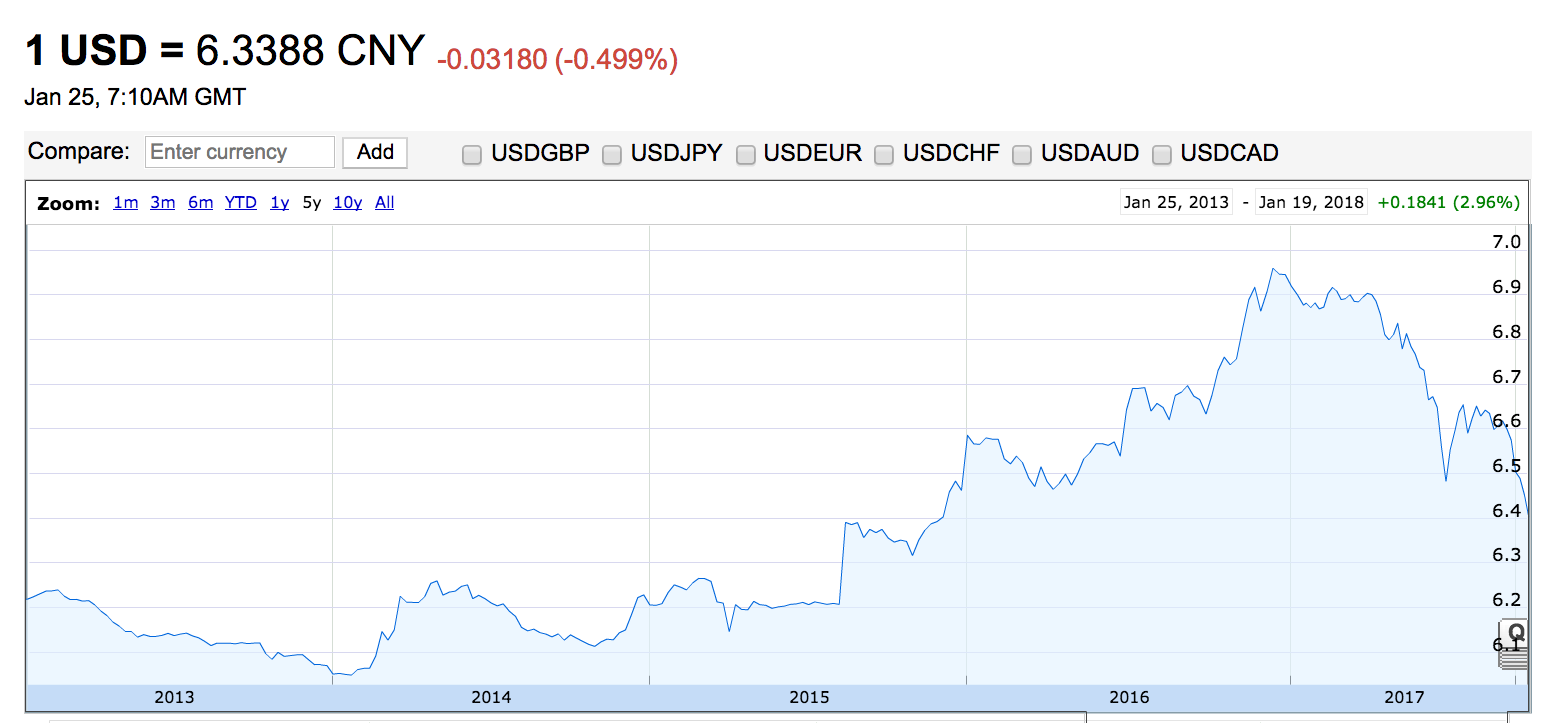“China’s intention to … keep the currency stable, with the objective of enhancing its role as a global reserve currency during the 2018 World Economic Forum, may lead to more yuan gains”, said Christy Tan, head of markets strategy and research for Asia at National Australia Bank.
Separately, state-backed Securities Daily newspaper cited Bank of China (Hong Kong)’s chief economist, E Zhihuan, as saying that yuan was likely to appreciate further because of dollar weakness as other central banks could exit from their quantitative easing policies quickly.
China Yuan could grow to level of British pound or Japanese Yen over ten years
The Bank of France confirmed that it held the Chinese currency as part of its reserves.
“In the long run, over the next decade or so, we expect the share of China in global reserves to increase to similar levels as to British pound and Japanese yen, both of which represent about 4.5% as of September 2017,” wrote FX strategist Adarsh Sinha and rates strategist Yang Chen of Bank of America Merrill Lynch.
Because the “global reserve allocations are a slow moving beast” rapid changes are unlikely, however, making this more important for the dollar in the long term rather than for its 2018 performance, according to Sinha and Chen. The buck’s role as the leading reserve currency “has been trending lower for close to two decades,” they wrote. “The correlation of the ICE U.S. Dollar Index with U.S. rates provides a real-time measure of when diversification is accelerating.”

Bundesbank board member Andreas Dombret said the decision was taken last year following an investment of 500 million euros ($611 million) by the European Central Bank, of which the German authority is a part. He said he wouldn’t comment on the amount that would be allocated
Trump Administration supporting weaker dollar policies
A day before Trump’s scheduled arrival in Davos for the World Economic Forum’s annual meeting, Treasury Secretary Steven Mnuchin endorsed the dollar’s decline as a benefit to the American economy and Commerce Secretary Wilbur Ross said the U.S. would fight harder to protect its exporters.
The greenback, extending its 2018 slide after Mnuchin spoke, is now at its lowest in three years as measured by the Bloomberg Dollar Index.

Continued Dollar Slide and China RMB catch up to Euro
Europe is China biggest trading partner. If the dollar slid so that the Euro was 25% stronger than a year ago, the Euro would be 1.31. The Euro is at 1.24. A year ago the Euro was at 1.05.
In 2014, the Chinese yuan reached 6.05 to the US dollar. If the yuan just kept up with the stability of the Euro then it could reach 5.5 on US dollar weakness.
A weak US dollar policy throughout the Trump term could see China economy pass in 2020 or 2021
There is more confidence in China economic growth with 6.9% in 2017 and solid 6.5-6.8% GDP growth projections for 2018 and 2019. This give China’s leadership confidence in allowing the yuan to strengthen against the US dollar and get close to the level of Euro strength. The US is following a weaker dollar policy.
GDP in yuan Exchange rate GDP nominal GDP with HK and Macau GDP per capita US GDP
2018a 90 trillion yuan 6.0 15.0 trillion 15.4 trillion $11160 $20.2 trillion
2018b 90 trillion yuan 5.5 16.4 trillion 16.8 trillion $12171 $20.2 trillion
2019a 99 trillion yuan 5.8 17.0 trillion 17.4 trillion $12600 $21.0 trillion
2019b 99 trillion yuan 5.3 18.7 trillion 19.1 trillion $13840 $21.0 trillion
2020a 109 trillion yuan 5.8 18.8 trillion 19.3 trillion $13800 $21.8 trillion
2020b 109 trillion yuan 5.2 21.0 trillion 21.5 trillion $15400 $21.8 trillion
2021a 119 trillion yuan 5.8 20.5 trillion 21.0 trillion $15000 $22.7 trillion
2021b 119 trillion yuan 5.2 22.9 trillion 23.4 trillion $16700 $22.7 trillion
Poland has an IMF projected 2020 GDP per capita of $16688.
By the end of the first quarter of 2018, China economy would have grown to about 84.5 trillion yuan (growing about 1.8 trillion yuan each quarter from the end of 2017 82.7 trillion), China’s nominal GDP would be US$14.1 trillion if the exchange was 6.0. GDP per capita would be over US$10,000.

Brian Wang is a Futurist Thought Leader and a popular Science blogger with 1 million readers per month. His blog Nextbigfuture.com is ranked #1 Science News Blog. It covers many disruptive technology and trends including Space, Robotics, Artificial Intelligence, Medicine, Anti-aging Biotechnology, and Nanotechnology.
Known for identifying cutting edge technologies, he is currently a Co-Founder of a startup and fundraiser for high potential early-stage companies. He is the Head of Research for Allocations for deep technology investments and an Angel Investor at Space Angels.
A frequent speaker at corporations, he has been a TEDx speaker, a Singularity University speaker and guest at numerous interviews for radio and podcasts. He is open to public speaking and advising engagements.

